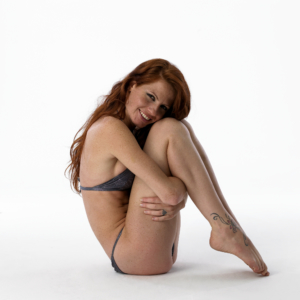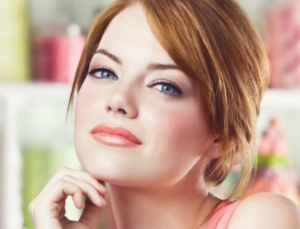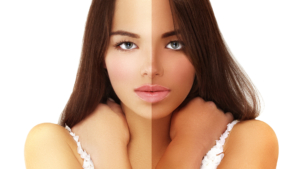
Pale, Ivory, porcelain, and fair skin-types such as pale blondes and red heads present some special challenges for the Spray Tanning technician.
- Very sensitive skin which may be more prone to product sensitivity reactions.
- Very Fair skin which is more prone to orange or brassy tones and uneven fading.
- Freckles which can over darken with self tanner.
- Working with the warmer skin and hair tones, so the tan does not “clash” or look over-red or to warm.
- Finding a product that looks “tan” but not over dark or screams “FAKE TAN HERE”
I am personally a very fair brunette, but have been a bottle Redhead for the past 25 years. Changing my hair color did impact both my makeup and self tanner choices. I am a warm tone skin type with hazel eyes, warm pale beige skin, with golden brown freckles/spots. (skintype II) Because I am very fair, my skin does look much like a Skin Type one in pigment depth. (as in I am very fair and wear very light and light foundations)
I have suffered a fair amount of UV damage due to my very pale skintype, and years of UV tanning in my youth, living in California. Though I never tanned well, I tried every single summer, and have had many burns, and current UV damage to show for it. This is not unusual with the fairest skin types. (I and II)
The Skin Type 1 or very white, fair, pale and ivory skin type can wear a beautiful sunless tan, but the key is to pick the correct DHA product level, and do not over apply.
Typically this will be a Caucasian client with pale blond or pale red hair, though some ( a few) darker haired brunettes can also be very pale skin type ones.
Eyes are generally pale, ether blue, or grey or light clear green.
The client generally wears very fair to pale foundation shade, (ivory, porcelain, pale, fair) burns easily, and quickly, when exposed to UV, and never , or only rarely, obtains a light UV tan. They mostly just redden or burn. These clients may also freckle very easily. Skin may be translucent, with many veins and capillaries visible. This can make skin look blueish in some lights. Skin may also have some red or rosy undertones. Skintype is generally seen as the “Porcelain Doll “look.
An example would be celebrity Emma Stone. (below from Revlon ad shoot). Other examples are Nicole Kidman, Anne Hathaway, Kate Blancehette, Margot Robbie, and Juillanne Moore.

This client skin type may complain that when they do use sunless tanners, or over the counter self-tanning products they “always” or very often turn orange.
This is an indication that they have been using too high a DHA level for their skin type, or applying to much product.
Product Recommendations/Tips:
These clients will often do best if you use your lowest DHA level products (5%-6% range), do not over apply (2 ounces only please), and make sure client does not leave product on the skin longer than 8 hours before they shower.
If leaving product on for 8 hours, gives them off color issues in brassy or orangey tones, advise client to shower off product earlier at 4-6 hours. This will provide a lighter final tan (color will darken over 12 – 24 hours), without poor coloration.
A highly moisturizing product will be slightly lighter, and tends to work especially well on this type of client. The Tan Extraordinaire 5% is the perfect example of a lower DHA level product in a moisturizing base to buffer final coloration. The tone is neutral to warm, depending on clients skin. This product tends to be very flattering to pale skin tones, especially redheads.
Skin type ones, may also be more prone to skin reactions. Assuming your client is not reacting to a specific plant extract, or DHA (Dihydroxyacetone – the self-tanning agent) – the most common reactive ingredients in any cosmetic are generally the fragrance or the dye component.
As always, make sure client is well exfoliated pretan. A large amount of color buildup from continual back to back tanning can also cause tan to look a bit orangy with time, as you are reapplying fresh product to old layers of color. Eventually you can get “to much” color, which can look a bit orangy and brassy in some cases. So regular exfoliation, and adjusting application amounts when “old” color is present on the skin, can help offset any tendency toward off coloration.
Though some of the fairer clients may dream of having a deep deep Brazilian dark tan, as often seen on darker skinned swimsuit models and cover girls, this is not something that can easily be realistically obtained on this skin type, with a sunless tanner only.
Remind the client that all photo shoots also use body makeup and bronzers on top of every sunless tan to enrich the final color, depth, and tone. Then all photos are adjusted in tone, and lighting with photo manipulation software (hello Photoshop!) See image below for an example of a Photoshop “tan” or Just GOOGLE “Photoshop Before After’s” for many online examples.

A sunless tanner is a sheer colorant, not an opaque paint coat; the clients natural lighter pigmented pale skin will show through. This will Lighten and change the color of the final tan.
You can experiment a bit with a few back to back tanning sessions over 2-3 weeks to build some base coats of color, and/or raising the DHA level a bit. But if you go to high, you will start seeing more orangey tones, or very fast and crackly fade off. A very dark tan, also tends to look ver fake if the client is very pale in skin, hair and eye naturally.
So use caution not to “over-promise” results to your client, that may not be possible with their skin type.
What About Freckles?
Freckles can ether “blend” into the skin better, when a client has a sunless tan, or can temporarily darken slightly. The difference really depends on the clients skin and freckle texture. Dryer skin, or freckles that are more raised, dryer, rougher, or a different texture than surrounding skin may darken slightly with a self tanner. (this will fade as the tan fades, but can take a few weeks longer for all excess color to leave the freckled area)
Those that are deeper, smoother, and the same texture as surrounding skin tend to “blend” more with the slightly darker tanned skin.
Using a moisturizer blend will help buffer the tan coloration, allowing it absorb more evenly into the freckled skin. This will provide more “blending” compared to use of a quick dry solution.
Spray tanning will not make freckles disappear. Because the tan is a sheer product, all skin “imperfections” will still be visible, though they may be blurred more. A make up product, or concealer would be needed to completely “cover/hide” freckles. This is what is normally used for stage ware or photo shots, and can be purchased in both facial and body makeup products lines.
When the skin is tanned, the contrast of the freckled skin weather they (freckles) are darken or not, will tend to look more “natural”, as tanned skin often does have more freckles naturally from cumulative UV damage. (Freckles are a result of UV damage). Therefore, freckles, when seen on “tanned” skin don’t look “odd” but rather as a result of a natural UV tan.
Because freckles are from UV damage, diligent use of sunscreen everyday will allow freckles to fade with time, as UV exposure is removed. Cosmetic products and treatments are also available to speed the fade rate, but daily high SPF sunscreen is a must. A sunless tanner will provide a low spf level of about 4, but this is not enough for adequate UV blocking.

Leave A Comment
You must be logged in to post a comment.